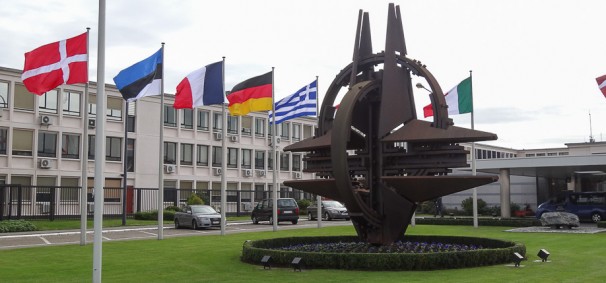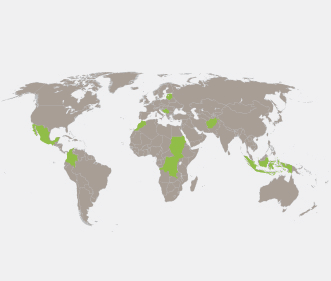The North Atlantic Treaty Organization’s (NATO) overall approach to security governance shifted twice during the course of the War on Terror. In response to new geopolitical pressures, NATO adopted a strategic stance that prioritized two different forms of out-of-area operations. A third shift, provoked by the crisis in Ukraine and an increasingly hostile Russia, is now arguably underway, one that could see a move away from out-of-area operations and a return to NATO’s original purpose of ensuring the collective defence of its members.
In the wake of September 11th, NATO soon found itself confronting an array of unexpected challenges when it took command of the International Security Assistance Force in Afghanistan. An alliance that had been designed to repel a hostile force was now tasked with peace support duties far outside its traditional area of operations. In order to succeed in this new mission, NATO adopted an expansive and long term strategy in dealing with stability operations in post-conflict states, as elaborated in its Comprehensive Approach (CA). With the CA, NATO opted for a multifaceted framework to post-conflict development – one that proffered a unified strategy and a singular focus, in which non-military development assistance non-governmental organizations (NGOs) and military units are brought together under the same command.
Yet, by blurring the lines between military and civil functions, the CA was fiercely resisted by development actors. Many feared that they would lose their non-combatant status, since the CA called for integrating their activities with and serving alongside NATO forces. Indeed, the one sustained example of the CA in action – the formation of provincial reconstruction teams in Afghanistan – has been widely decried as a failure which threatened the lives of humanitarian workers.
Ironically, the large scale rejection of CA by humanitarian actors only further militarized the provision of aid and development in Afghanistan. NATO was forced to become more directly involved in the reconstruction process, triggering further protests by development NGOs and a growing reluctance by them to work within the CA framework. Thus CA is unlikely to be used as a model for development in the future, due not only to the difficulties of putting it into practice but also because the high cost of peace support on the scale demanded by the CA, which will be difficult to replicate in the future. This is especially true in today’s fiscal environment, where austerity limits the financial resources available in the West and constrains the ability of NATO to carry out any prolonged out-of-area missions.
The second approach that NATO adopted arose following the 2008 Great Recession and was officially proclaimed in its 2010 Strategic Concept. Collective defence – the basis upon which NATO was founded and its central operating principle for more than fifty years – was conceptually and practically diminished in importance. In its place, rather than the robust and sustained security operations envisioned in CA, crisis management was elevated to the centerpiece of NATO strategy.
The shift to crisis management resulted in a fundamental change in NATO’s behavior. Under the logic of collective defence, it was well understood that NATO would only respond to a direct attack against one of its members; under the crisis management rubric, NATO adopted a far more proactive and aggressive posture. The alliance would now seek to respond to and contain threats as they emerge, rather than in response to an attack. This change is due to the fundamentally different perceptions of the world inherent within each approach. Central to the logic of collective defence is the belief that the world is the largely static and predictable. In contrast, crisis management sees the world as chaotic and unpredictable. Collective defence assumes that the world will remain largely the same, while for risk management the future is indeterminate.
Crisis management became NATO’s predominant approach for largely two reasons. First it offered techniques that allow for connections to be drawn between the seemingly distinct entities that challenge the West, enabling policy makers to make sense of what would otherwise be an inconceivable set of dangers. Second, crisis management was seen to improve the efficiency by which threats could be identified and reduce the cost with which these threats could be eliminated. In contrast to lengthy and expensive CA-style operations, such as in Afghanistan, crisis management was conceived to entail relatively short operations that lacked any sustained or coherent peacebuilding component afterwards, thus significantly reducing their cost. In this regard, NATO’s most recent operation in Libya can be seen as an exemplar of a crisis management operation in action.
While distinct from one another, both CA and crisis management are outward looking approaches that assumed security issues in Europe continent were largely settled with the end of the Cold War. With Russia’s recent annexation of Crimea, continuing instability in Eastern Ukraine, and the return of geopolitics to the European continent, these assumptions no longer hold. NATO spent more than a decade fixated on regions outside of its traditional area of operations. Now Russia’s actions in Ukraine, and the consequent need to reassure its concerned Baltic members about their own territorial integrity, are forcing NATO to shift its strategic focus back to its borders with Russia. Collective defence is once again at the centre of NATO strategy.
However, NATO will have to rely on a modified form of collective defence. Russia has adopted a hybrid or non-linear style of warfare in Ukraine – one that involves covert use of Special Forces and intelligence agents, local proxies, mass disinformation campaigns, intimidation through displays of military strength, and all manner of economic coercion. Collective defence against these types of attacks will not succeed if NATO simply reinvests in traditional military forces, such as tanks, artillery, and nuclear deterrents. Instead NATO will have to prioritize a new set of assets, including intelligence, surveillance and reconnaissance, command and control, border management, and the capacity to deploy forces rapidly throughout Europe. Further, the alliance will have to adopt an approach to defence modernization that focuses on creating the most resilient and functional member states capable of rapidly detecting and blocking covert attempts at intrusion
In just over a decade, NATO has outlined and employed three different strategic perspectives that have informed how it approached stability operations, engagement with outside actors, and security governance more broadly. That it has been forced to rapidly elaborate alternative doctrines could be read as a sign of weakness, of NATO simply lurching from crisis to crisis, with no overall coherence.
A contrasting and I believe more accurate assessment is that these shifts illustrate the flexibility of NATO by demonstrating its ability to rapidly shift in response to contemporary events. Were NATO to continue to deploy the same strategy in a rapidly altering geopolitical environment, it would quickly slide into irrelevance. By effectively responding to the challenges faced by its members, NATO remains a viable and vibrant security organization – one that has been the centerpiece of the Western security community for well over six decades.
Matthew Morgan is a Research and Communications Intern at the Centre for Security Governance.
Tags: collective defence, crisis management, NATO, PRT






 Visit the Centre for
Visit the Centre for